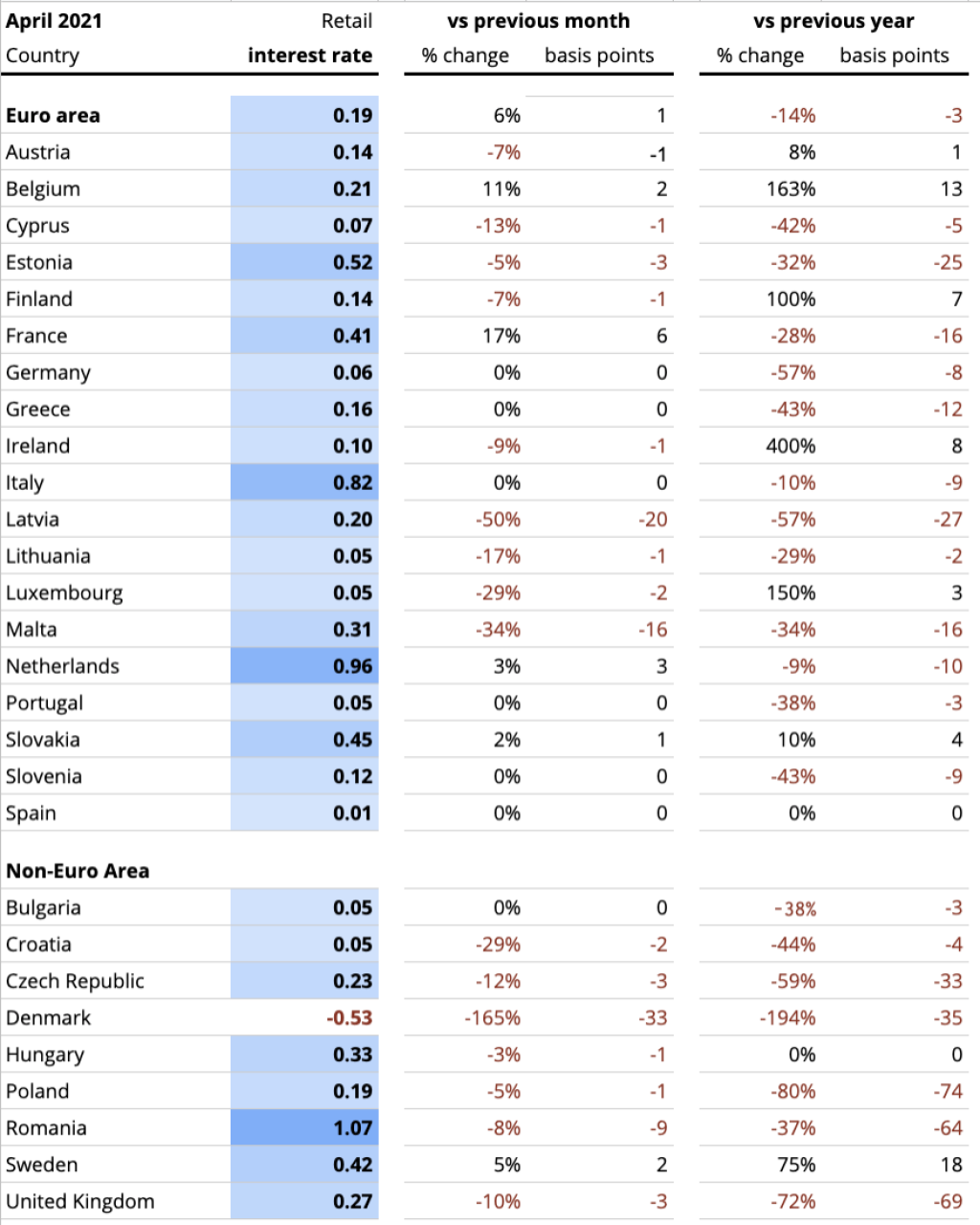Unlock Your Financial Potential With Unbeatable Retail Bank Savings Rates – Take Action Now!
Retail Bank Savings Rates: A Comprehensive Guide
Greetings, Readers!
Welcome to our informative article on retail bank savings rates. In this guide, we will provide you with a thorough understanding of this topic, its advantages and disadvantages, as well as frequently asked questions. Whether you are a seasoned investor or someone looking to start saving, this article will help you make informed decisions. So, let’s dive in!
1 Picture Gallery: Unlock Your Financial Potential With Unbeatable Retail Bank Savings Rates – Take Action Now!

Introduction
Retail bank savings rates refer to the interest rates offered by banks on savings accounts. These rates determine how much money you can earn on your savings over time. It is crucial to understand these rates, as they affect your ability to grow your wealth and achieve your financial goals.
1️⃣ What are retail bank savings rates?

Image Source: raisin.com
2️⃣ Who sets these rates?
3️⃣ When do the rates change?
4️⃣ Where can you find the best rates?
5️⃣ Why do retail bank savings rates matter?
6️⃣ How do retail bank savings rates work?
What are retail bank savings rates?
Retail bank savings rates represent the percentage of interest an individual can earn on their savings. These rates vary from bank to bank and can be influenced by various factors such as market conditions, government policies, and competition among financial institutions.
Understanding how these rates are determined is essential for making informed decisions about where to save your money. It’s important to compare rates across different banks to ensure you are getting the best return on your savings.
Factors Affecting Retail Bank Savings Rates
Several factors influence retail bank savings rates:
1️⃣ The central bank’s monetary policy: The central bank’s decisions regarding interest rates have a significant impact on retail bank savings rates. When the central bank lowers interest rates, it tends to reduce the rates offered by retail banks as well.
2️⃣ Economic conditions: The overall economic climate, inflation rates, and the demand for borrowing can also influence retail bank savings rates. During times of economic growth, rates may be higher, while during economic downturns, rates tend to decrease.
3️⃣ Competition among banks: Banks compete with each other to attract customers and deposits. This competition can lead to higher savings rates as banks try to entice individuals to choose their institution.
4️⃣ Deposit insurance: In some countries, retail bank savings rates can be influenced by deposit insurance schemes. These schemes provide protection to depositors in the event of a bank failure and may affect the rates offered by banks.
5️⃣ Bank profitability: The financial health and profitability of a bank can also impact its ability to offer competitive savings rates. Banks with stronger financial positions may be able to offer higher rates to attract customers.
6️⃣ Market conditions: External factors such as changes in global interest rates and market conditions can also influence retail bank savings rates.
Who sets these rates?
Retail bank savings rates are primarily set by individual banks based on various internal and external factors. The central bank’s monetary policy decisions, as well as market conditions, play a significant role in determining these rates. However, each bank has the flexibility to set its rates within a certain range.
It’s important to note that retail bank savings rates can vary significantly between banks. Therefore, it is advisable to research and compare rates offered by different banks before making a decision.
When do the rates change?
Retail bank savings rates can change frequently due to several factors:
1️⃣ Central bank decisions: Changes in the central bank’s monetary policy, such as interest rate adjustments, can prompt retail banks to revise their savings rates accordingly.
2️⃣ Economic conditions: Shifts in the overall economic environment, inflation rates, and market conditions can also lead to changes in retail bank savings rates.
3️⃣ Bank-specific factors: Banks may decide to change their savings rates based on their financial health, profitability, and competition within the market.
It is important to stay updated on the latest changes in retail bank savings rates to take advantage of favorable rates or make necessary adjustments to your savings strategy.
Where can you find the best rates?
When searching for the best retail bank savings rates, consider the following options:
1️⃣ Online banks: Online banks often offer higher savings rates compared to traditional brick-and-mortar banks due to lower overhead costs.
2️⃣ Credit unions: Credit unions are not-for-profit financial institutions that often provide competitive savings rates to their members.
3️⃣ Local community banks: Local community banks may offer personalized service and competitive rates to attract and retain customers.
4️⃣ High-yield savings accounts: Some banks offer specialized savings accounts that provide higher interest rates but may have additional requirements.
Researching and comparing rates from different banks and financial institutions can help you find the best savings rates that align with your financial goals.
Why do retail bank savings rates matter?
Retail bank savings rates play a crucial role in personal finance and wealth-building for several reasons:
1️⃣ Accumulating wealth: Higher savings rates allow your money to grow faster over time, helping you accumulate wealth and achieve financial goals.
2️⃣ Passive income: Savings accounts with competitive rates can provide a steady stream of passive income as your savings generate interest.
3️⃣ Emergency funds: A high-interest savings account can serve as an emergency fund, providing you with financial security in times of unexpected expenses or job loss.
4️⃣ Retirement planning: Saving with higher rates can significantly impact your retirement savings, ensuring you have enough funds for a comfortable retirement.
5️⃣ Investment opportunities: A strong savings foundation can open doors to other investment opportunities, such as stocks, bonds, or real estate.
How do retail bank savings rates work?
Understanding how retail bank savings rates work is essential for maximizing your savings potential:
1️⃣ Compound interest: Most savings accounts use compound interest, which means that your savings earn interest on both the initial deposit and the accumulated interest over time. This compounding effect can significantly boost the growth of your savings.
2️⃣ Annual percentage yield (APY): APY represents the actual rate of return on a savings account, including compounding effects. It takes into account the frequency of compounding and allows for easier comparison between different savings accounts.
3️⃣ Interest calculation: Banks may calculate interest using different methods, such as daily or monthly average balances. Understanding how interest is calculated can help you estimate your earnings accurately.
4️⃣ Terms and conditions: Some savings accounts may have specific terms and conditions, such as minimum balance requirements or limitations on withdrawals. Familiarize yourself with these terms to avoid any penalties or restrictions.
By understanding these concepts, you can make informed decisions when choosing a savings account and leverage the power of retail bank savings rates to grow your wealth.
Advantages and Disadvantages of Retail Bank Savings Rates
It’s important to consider both the advantages and disadvantages of retail bank savings rates before making decisions about where to save your money:
Advantages
1️⃣ Security: Retail bank savings accounts are generally considered safe and insured by deposit insurance schemes, providing protection for your savings.
2️⃣ Liquidity: Savings accounts offer high liquidity, allowing you to access your funds whenever needed without penalties or restrictions.
3️⃣ Minimal risk: Compared to other investment options, savings accounts carry minimal risk, making them suitable for conservative investors or short-term savings goals.
Disadvantages
1️⃣ Lower returns: Retail bank savings rates often provide lower returns compared to other investment options, such as stocks or bonds.
2️⃣ Inflation impact: Inflation can erode the purchasing power of your savings, especially if the interest rate is lower than the inflation rate.
3️⃣ Opportunity cost: By solely relying on savings accounts, you may miss out on potential higher returns from other investment opportunities.
Consider your financial goals, risk tolerance, and time horizon when weighing the advantages and disadvantages of retail bank savings rates.
Frequently Asked Questions (FAQs)
1️⃣ Q: Are retail bank savings rates the same for all account types?
A: No, savings rates can vary depending on the account type, such as regular savings accounts, high-yield savings accounts, or certificates of deposit (CDs).
2️⃣ Q: Can I negotiate retail bank savings rates with my bank?
A: In most cases, retail bank savings rates are non-negotiable. However, you can still shop around for the best rates available in the market.
3️⃣ Q: Is it worth opening multiple savings accounts to take advantage of different rates?
A: It can be beneficial to open multiple savings accounts if each account offers unique benefits or higher rates. However, ensure that you can manage the accounts effectively and consider any potential fees or minimum balance requirements.
4️⃣ Q: Do retail bank savings rates affect loan interest rates?
A: While retail bank savings rates and loan interest rates are influenced by similar factors, they are not directly linked. Banks determine loan interest rates based on factors such as creditworthiness, loan term, and market conditions.
5️⃣ Q: What should I do if my bank lowers its savings rates?
A: If your bank lowers its savings rates, you may consider exploring other banks or financial institutions that offer higher rates. Transferring your savings to another institution with better rates can help you maximize your earnings.
Conclusion
In conclusion, retail bank savings rates are a crucial aspect of personal finance and wealth-building. By understanding how these rates work, who sets them, and where to find the best rates, you can make informed decisions about your savings strategy.
Remember to weigh the advantages and disadvantages of retail bank savings rates and consider your financial goals and risk tolerance. Additionally, stay updated on changes in rates and explore different options to ensure you are maximizing your savings potential.
Take action today by researching the best retail bank savings rates and opening an account that aligns with your financial goals. Start building a strong foundation for your future financial success!
Final Remarks
Disclaimer: The information provided in this article is for educational purposes only and should not be construed as financial advice. Before making any financial decisions, we recommend consulting with a professional financial advisor.
Thank you for reading, and we hope this guide has provided you with valuable insights into retail bank savings rates. If you have any further questions, feel free to reach out to us. Happy saving!
This post topic: Shopping Savings



